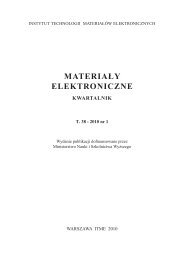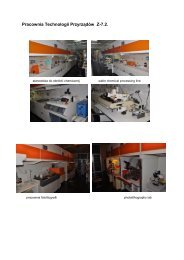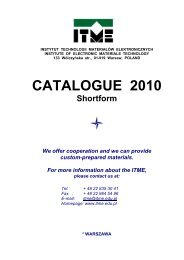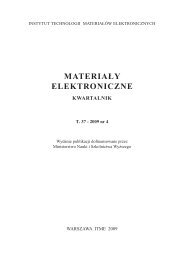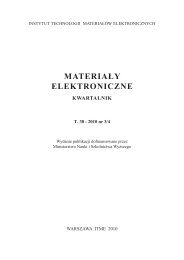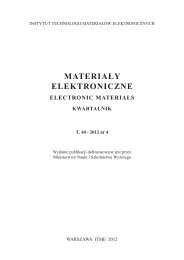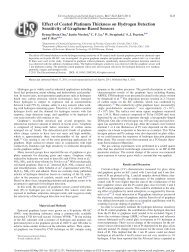Nr 1 - ITME
Nr 1 - ITME
Nr 1 - ITME
Create successful ePaper yourself
Turn your PDF publications into a flip-book with our unique Google optimized e-Paper software.
Z. Szczepański, R. Kisiel<br />
*<br />
- adhesives made by Epoxy Technology,<br />
a<br />
- silver filled glass made by Loctite,<br />
b<br />
- silver filled glass made by <strong>ITME</strong>, Poland,<br />
**<br />
- thermally conductive tape made by 3M,<br />
c<br />
- Ag nanopowder made by AMEPOX Ltd, Poland.<br />
Adhesive bonding with the use of organic conductive compositions is very<br />
common assembly process used in low power silicon devices, but for SiC power<br />
devices has limited application. Some of these compositions based on polyimide<br />
matrix (e.g. P-1011 Epoxy Technology) characterize high thermal resistance, what<br />
allows for working temperature even above 300ºC [14], but its insufficient thermal<br />
conductivity limits its application in SiC power devices. Better solutions are inorganic<br />
conductive compositions based on silver filled glass (e.g. FO-3, FO-23) which<br />
are good alternative for high temperature applications [15-16]. These compositions<br />
have satisfactory adhesion and provide high thermal and electrical conductivity,<br />
what is main demand for power electronics. The last option for SiC die attach are<br />
silver nanoparticles sintered in low temperature, which allow to obtain high temperature<br />
joint resistance with the good thermal conductivity. This die attach process<br />
has developed during the last years [17-18] and is still in research phase [19-20].<br />
This bonding technique can be used for high temperature SiC devices, where the<br />
operating temperature may be above 500ºC and where none of the known solders<br />
and conductive adhesives can work. Some of above mentioned die attach processes<br />
have been taken into account and applied in our researches. The adhesion of SiC<br />
die to ceramic substrate bonded by different technologies as well as their stability<br />
in temperatures above 300°C applications were measured and analyzed.<br />
2. EXPERIMENTAL PROCEDURE<br />
Our studies were focused on the following die attach technologies:<br />
1. solder bonding by means of gold-germanium eutectic alloys,<br />
2. adhesive bonding with the use of organic conductive compositions,<br />
3. adhesive bonding with the use of inorganic conductive compositions,<br />
4. die bonding with the use of thermal conductive adhesive tape,<br />
5. die bonding with the use of silver nanoparticles.<br />
The scheme of test sample for adhesion measurements is presented in Fig. 1.<br />
The SiC die bottom surface as well the surface of thick film on alumina substrate<br />
were prepared for joining. For adhesive bonding with the use of organic or inorganic<br />
conductive bonding, the SiC die was cleaned in organic solvents (trichloroethylene,<br />
acetone and propanol). For bonding with the use of Au-Ge solder and Ag<br />
nanoparticles after cleaning, on the SiC bottom surface the adhesive layers of Ni<br />
(100 nm) and Au (400 nm) were deposited by evaporation. The ceramic substrates<br />
101





